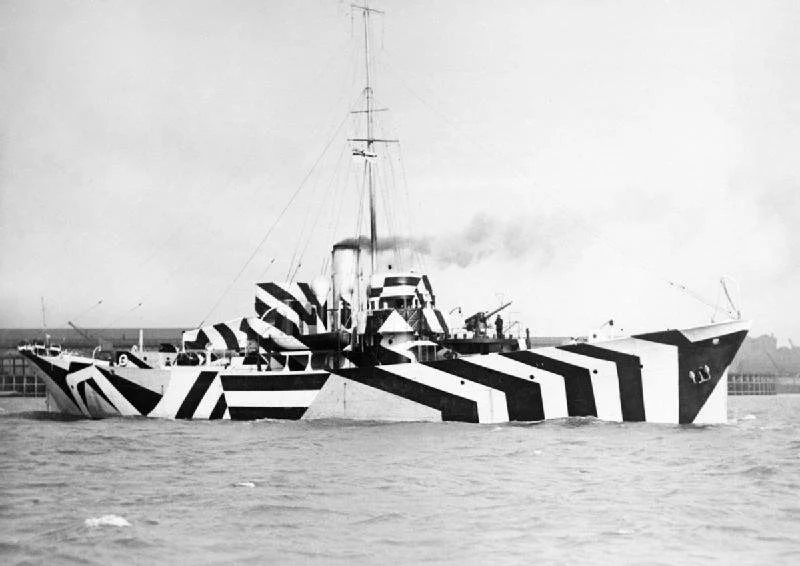
What Is Dazzle Camouflage?
In the kingdom of animals, there is a type of special avoidance mechanism where an animal depends on bright colors and patterns on their skin to disguise its movements, using it as a visual trick to cover the actual speed and pattern of movement of the excited predator. Zoolologists call it “camouflage fascinated.”
However, there are also interesting stories about how human beings borrow this idea from animals and use them in war. Historians lovingly call it “Razzle Dazzle.” The idea is not to hide the ship in front of the eye. Instead, he relied on painting complex patterns on the exterior of the ship so that the enemy had difficulty finding out its size and predicted its movement.
The same is too much, it sounds really successful. This was used recently as the first world war, brought disaster between 1914 and 1918. This concept was towards the 21st century, although for vehicles full of gas around us. Here is a brief idea of how charming camouflage has been used throughout history, and how it continues to be as effective as in modern times where the camera is around us.
History of the Razzle-Dazzle War
Until the first World War, the British Royal Navy was an indisputable ocean champion, but the supremacy was against other ships. When the deadly German navy submarine is known as U-Boats-entering the commotion, all hell is released. The ships suddenly became an easy target for enemies that could launch a destructive torpedo. To avoid this, some ideas were thrown.
Some want to make the ship look like a whale. Some thoughts propose the idea that they must be covered by a reflective mirror. Great inventor Thomas A. Edison reportedly wanted to turn the ship into a moving island. He really had to show his idea at SS Ockenfels, but that was not proven as popular as his other discoveries. Insert Lucien-Victor Guirand de Scévola, a French painter who pioneered the idea of painting on the artillery and posts as a measure of camouflage defense.
But British artist Norman Wilkinson who brought ideas to the sea and disguised thousands of warships. After being painted, the ships were found effective in war, and Wilkinson was handed over by all departments called the Dazzle part of the British Navy. He is also officially recognized as the creator of enchanting techniques. There is a short video of an interesting UK discovery about the art of fascinated paintings and how it was widely adopted by the British and allies military. There are also some photography samples here.
How does it work?
Historians have classified the discovery of the charming camouflage as a genius stroke. On the surface, the idea of painting a cool pattern on the ship and making it stand out doesn’t make sense, because it will make it an easy target. But in reality, the geometric pattern made of contrasting colors, curves, and shapes not only helps cover the actual vehicle size, but also enemies who are confused about observing their true shape and where it goes when observed through periscope.
A certain corrugated curve pattern will make the ship look smaller and also shift the movements that are felt in different directions. All of these tricks make it very difficult for the enemy to target camouflage ships like that with torpedo. Precisely the way of modern sniper studying everything from wind speed to enemy movements before taking shots, Torpedo U-Boat must also be launched after assessing the size and speed of the ship.
It’s less about just pulling the trigger and more about predicting where the enemy ship will be one minute after launching the torpedo. By disguising ships, it becomes difficult to determine the relative position of the ship a few minutes ahead. Hurrring the target movement even a few degrees are enough to miss the target, and this allows ships to avoid torpedo. Dazzle disguise can still be found on ships such as USS Freedom, but its use has been drastically reduced in the modern era.
Modern Avatar from Fascinated Camouflase
In the 21st century, the fascinated camouflage had switched from a sea war to a less destructive domain – a car. Like celebrities who often hide behind a strange hat and thick shades, car makers wrap the test model with a skin that has a complicated pattern to hide the contours and actual lines. The headlights and grids are usually covered with items such as vinyl, rubber, and tape.
Swirl and zigzag patterns act as noise visuals to disguise the actual design. Rotad, haphazard calligraphy patterns, sloping boards, and harlequin designs, among others, are widely employed by people like BMW, Range Rover, and Ford to hide their cars that will come from the eyes and excited lenses. “We want to save a big splash when things come out look beautiful and beautiful,” Chevrolet Engineer Andrew Farah was quoted as saying by Autoblog.
The brand is really trying hard to ensure that their upcoming project remains a secret. From renting a horse racing with a fake name to employing a security team that explores the entire area for hidden cameras, many enter the process. According to Forbes reports, eye photographers can produce between $ 300 to $ 10,000 for these eye shots. While camouflage paints do not hide everything, at least they throw the camera (and naked eye) from making details and better car pieces.



Average Rating